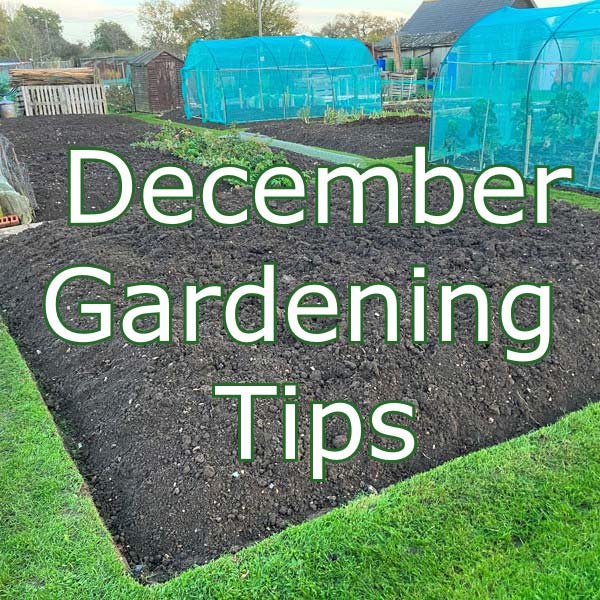Growing Carrot Seeds for All Season
14 December 2022Andrew Tokely's Gardening Tips for December!
02 December 2022With the festive season just around the corner, there are still a few jobs that need attending so we are all ready for the New Year ahead.
1. Carry on with Winter digging of your vegetable plots, I like to try and get this job done by the new year , so the cold frosty winter weather can help break down the soil. I think a tidy winter plot always looks great and you have the satisfaction that this is a good job done , and once completed you can sit back and relax what ever the weather.
2. If the weather is too cold or wet to do any jobs outside, then there are plenty of jobs to do in the warmth of the greenhouse or shed to prepare for next year. A clean of all the sowing equipment is required. Wash pots and seed trays with soapy water, so they are clean and ready for use early next year. Propagators and benches can also be washed down so they are clean from any pests or fungal diseases that may be hiding in those tiny crevices. This will give us all a clean start to the year ahead.
3. Remember during very cold weather to look after the birds regularly. Leave our bird feed and top up the birdbath so they have some fresh water to drink. If you encourage the birds into your garden at this time of year, hopefully they will also return next spring to nest and feed on some of the aphids and other pests that can cause us gardener’s problems.
4. On Christmas day, I will be busy sowing my Large Onions. Christmas or Boxing Day is the traditional time for sowing this vegetable, plus it will give me a good excuse for getting out of the washing up. I sow the variety Globo, Mammoth or Ailsa Craig, as these will grow into whoppers over 1-2lb in weight. Onion Seeds need sowing onto the surface of moist seed sowing compost, and then they should be lightly covered with fine grade vermiculite. Once sown, place in a heated propagator set at 20C (70F). Germination usually takes 10-14 days.
5. Give yourself time to harvest Vegetables for the Christmas lunch a few days before they are required. This year I will be enjoying Parsnip ‘Gladiator’ , Carrots ‘Eskimo’, Brussels Sprout ‘Brodie’, Red Cabbage ‘Red Lodero’, Savoy Cabbage ‘Wintessa’ all harvested fresh from my plot , along with from storage some Onion ‘Santero’ for flavour to the meat juices and Potato ‘Setanta’ to make my Roasties.
6. December is the ideal month for pruning Blackcurrants. Now that all the leaves have fallen off the plants it makes it easier to see what you are doing. When pruning Blackcurrants you should cut out as much old wood as possible to leave just young growth, that is less than 3 years old. The younger shoots will grow more vigorously and in turn will produce more fruit. The older wood is easily recognised because it is much darker in colour than the younger shoots, and often the bark is a lot rougher. Always try to prune down to a healthy new bud as close to the base of the plant as you can. This will help encourage new shoots to grow from the base. Once pruned give the blackcurrant plants a generous mulch of well-rotted manure or garden compost.
7. Check your apples and pears in storage this winter for signs of damage or rot. Removing this will stop fungal spores spreading to the rest of your fruit.
When the weather is cool and dry, take advantage of these nice days to dig the vegetable plot. If this job is done from now until the New Year you will have a neat and tidy plot ready for the new season. I always dig in plenty of well-rotted manure or mushroom compost to help add some nutrients and structure to the soil. I find digging pleasurable as well as a great way of keeping fit and it helps burn off any of those calories that I may have put on over the festive period.
8. If you have some large clumps of Rhubarb, why not cut a piece off and leave it lying on the top of the ground this month to get frosted. This cold period will spur the growth buds into developing sooner. Leave the Rhubarb laying there for several weeks until it has been frosted several times, then pot it up and move it into a warm (Not hot) greenhouse or shed. This will then start to produce some tender sticks of Rhubarb for you to enjoy early next spring.
9. It always surprises me how much colour and scent there is in the garden at this time of year. Rather than leave this scent outdoors why not cut a few stems of winter flowering Honeysuckle, Viburnum and Mahonia as they show colour and place them in a vase of water indoors. Then as the buds open they will fill your rooms with their colour and fragrance.

Read More